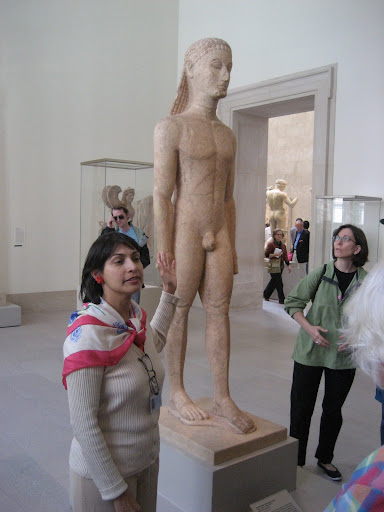(Photo: Chris Harris)
SCULPTURE OF A KOUROS (YOUTH)
Researched by Rochelle Almeida
32.11.1
Artist Unknown
Naxian Marble sculpture
Height (without plinth): 76”
Greek, Attica
580 B.C. Archaic
What does this sculpture represent?
This is a statue of a “kouros”, Greek for “youth” (plural: “kourai”). It is a funerary statue, which means that it would have adorned the grave site of the deceased, in this case, quite presumably a noble and healthy human being who, unfortunately, died young. Neither the identity of the subject represented in this statue nor the identity of the carver is known to us. It was customary for the Greeks to commemorate their dead with statues of this kind and several funerary pieces survive. However, it is rare to find one that depicts the entire physique of a young man.
How old is this sculpture?
This statue was made around 580 B.C. during the Greek Archaic period—this makes it one of the oldest pieces to be found in the Metropolitan Museum. This is indeed one of the earliest freestanding marble statues of a human figure carved in the Attica region of ancient Greece.
Methods and Materials:
The Kouros is carved out of a single slab of marble. What makes it remarkable is that it is free standing, which means that it has no support system to bear its weight. This is a difficult feat to achieve since the base provides the only surface upon which the entire figure balances. It is extremely difficult to carve a large figure with all the weight carrying down through the two legs with no added support along the sides. This represents a huge step in success for the sculptor has achieved his goal of liberating the figure from its original block of stone. In doing so, he achieved a more natural, well-balanced appearance, endowing the Kouros with an extraordinarily life-like vitality. This figure is slender and elegant with the alert, elastic physique of a sprinter. The availability of iron for knives and chisels and the use of drills and wedges enabled Greek sculptors to make rapid progress in their carving techniques.
After being carved, the kouros would have been painted in bright, vivid colors, some remnants of which are still faintly visible. Age and time have taken their toll on this statue and the paint has naturally worn away.
Visual Details:
The Kouros stands in a frontal pose, its arms held alongside the body, joined to it below the armpits and ending in clenched fists. The entire face has clear-cut features that pronounce an almost aristocratic bearing. There is a sense of nobility conveyed by the muscular torso, the long neck, powerful arms and legs and the merest hint of a smile.
The Kouros has an interesting hairstyle. The curly long hair hangs down behind in fourteen lovely beaded tresses. An encircling fillet is tied behind in a reef knot and has long ends that hang loosely down.
As one’s eyes move further down the statue, one is struck by the anatomical detail of the piece. Each nerve, muscle and sinew seems to be lovingly detailed by the carver’s chisels. Muscles bulge above the kneecap. A look at the calves at the back suggests the merest hint of a vein. This is a highly naturalistic carving, through which the sculptor has attempted to convey the vigor and poise of a handsome and healthy man, brimming with the joie de vivre of life. It is such a pity when one considers his youth that he enjoyed such a short life. Perhaps it is a testimony to the old adage that “Those whom the Gods love, die young”.
Significance of this sculpture:
The Kouros is interesting because it points very clearly to the influence of the Egyptians upon the Greeks. If you get a chance to see the Temple of Dendur in our Egyptian Wing, you will notice the manner in which the Egyptians depicted the human figure. Men are always depicted with their left legs stepping forward and this is exactly the pose of this Kouros. According to Herodotus, the Greeks were introduced to Egyptian civilization after the pharaoh Psammetichos hired Ionians as mercenaries in the middle of the 6th century B.C. Accordingly, the Greeks learned how to quarry stone and plan the execution of large scale statues from the Egyptians who had been working with stone for centuries. Besides, the Kouros recalls Egyptian design in the pose, in the broad, square shoulders and in the rigidly frontal and symmetrical designs.
Nudity in Greek Art also has special importance. The Greeks, unlike the Egyptians, had no reservations about representing male human figures in the nude. No other contemporary culture had this custom. The Kouros, unlike Egyptian figures that are seen to be wearing kilts, is depicted in the nude, as the Greeks believed that physical beauty reflected inner nobility. They also considered that nudity had a connotation of heroic excellence. Indeed, they participated in some heroic contests, including some events in the ancient Olympics, in the nude—the better, they believed, to showcase the perfection and naturalness of the athletic human figure. Nudity also separated male from female; Greek from foreigners.
For a long time, this Kouros was said to represent Apollo. Indeed it was called the archaic Apollo. To the Greeks, Apollo, a protector of young men, was himself in appearance, simply a glorified young man.
Conclusion:
The unknown sculptor of this work has done a remarkable service to his unknown subject—he has depicted him in all his human perfection, but the fact that it stood upon a grave, reminds us inevitably of the finality of death.
BIBLIOGRAPHY:
Boardman, John. Greek Sculpture: The Archiac Period. New York: Thames & Hudson, 1978.
The Metropolitan Museum of Art Guide. Second Edition. New York: MMA, 1994.
Richter, Gisela M. A Catalogue of Greek Sculptures. Cambridge, Massachusetts: Harvard University Press, 1954.
———————- Kouroi: Archaic Greek Youths: A Study of the Development of the Kouros Type in Greek Sculpture. New York: Hacker Art Books, 1988.
